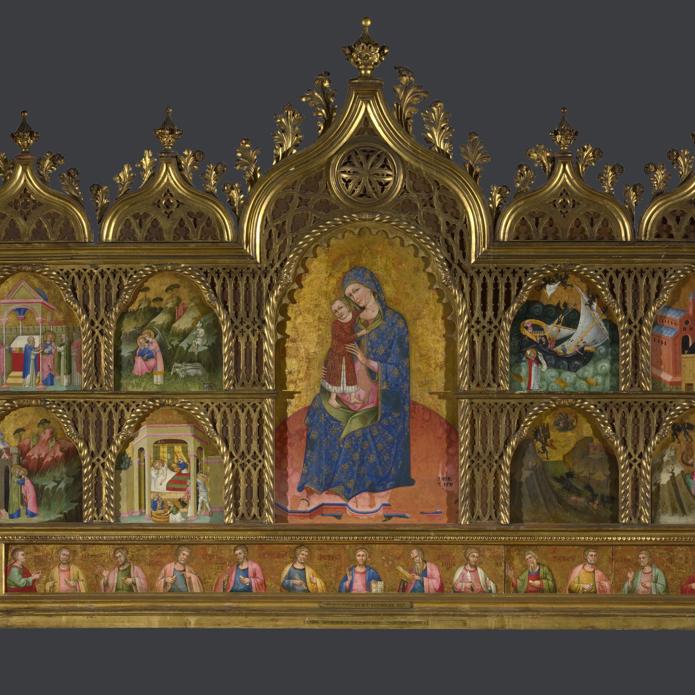Dalmatian/Venetian, 'Two Apostles (Saints Andrew and Thaddeus)', about 1400
About the work
Overview
This is one of three sections of a predella, the lowest part of an altarpiece. The main panels of the altarpiece show the Virgin and Child, surrounded by narrative scenes of the lives of the saints. The predella originally showed Christ at the centre with the 12 apostles, his followers who preached his message after his death, but it was cut into three some time before it entered the National Gallery’s collection.
These two men, from the right part of the predella, are saints Andrew and Thaddeus. They are shown as old men with white beards, holding scrolls. The inscription in red between them is Thaddeus’s name: S. TADEV
Key facts
Details
- Full title
- Two Apostles (Saints Andrew and Thaddeus)
- Artist
- Dalmatian/Venetian
- Part of the group
- Altarpiece of the Virgin Mary
- Date made
- about 1400
- Medium and support
- egg tempera on wood
- Dimensions
- 13.8 × 26.4 cm
- Inscription summary
- Inscribed
- Acquisition credit
- Bequeathed by H.E. Luxmoore, 1927
- Inventory number
- NG4250.7
- Location
- Not on display
- Collection
- Main Collection
- Previous owners
Provenance
Additional information
Text extracted from the ‘Provenance’ section of the catalogue entry in Dillian Gordon, ‘National Gallery Catalogues: The Italian Paintings before 1400’, London 2011; for further information, see the full catalogue entry.
Bibliography
-
1951Davies, Martin, National Gallery Catalogues: The Earlier Italian Schools, London 1951
-
1986Davies, Martin, National Gallery Catalogues: The Earlier Italian Schools, revised edn, London 1986
-
1988Gordon, Dillian, National Gallery Catalogues: The Early Italian Schools before 1400, revised edn, London 1988
-
2001
C. Baker and T. Henry, The National Gallery: Complete Illustrated Catalogue, London 2001
-
2011Gordon, Dillian, National Gallery Catalogues: The Italian Paintings before 1400, London 2011
About this record
If you know more about this painting or have spotted an error, please contact us. Please note that exhibition histories are listed from 2009 onwards. Bibliographies may not be complete; more comprehensive information is available in the National Gallery Library.
Images
About the group: Altarpiece of the Virgin Mary

Overview
This altarpiece is a unique example in the National Gallery’s collection of a work made by a late medieval artist working on both sides of the Adriatic, the sea between Italy and the Balkan coast. The picture may be one of the earliest painted representations of the Virgin of the Immaculate Conception (the Virgin being conceived without sin). This was a controversial idea in this period. It was not officially included in Catholic theology until the nineteenth century, but it was celebrated in the fifteenth century, on 8 December.
The central panel showing the Virgin and Child includes celestial bodies – the sun, moon and stars – that became associated with the Immaculate Conception. The left side panels show the story of the Virgin’s miraculous birth to a couple who could not have children; the right side panels shows two miracles of the Virgin.








